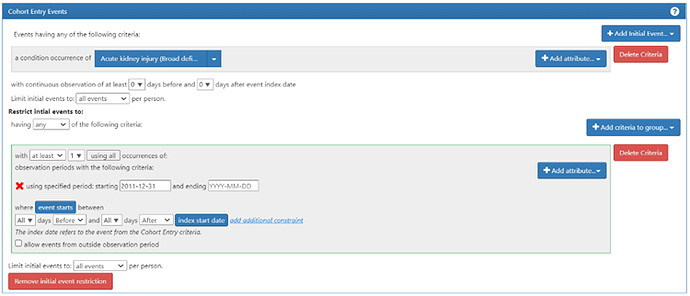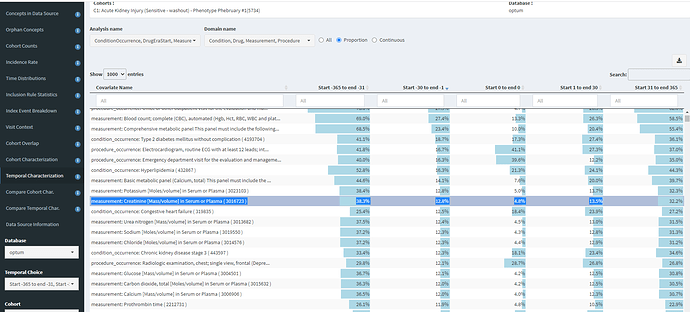Even though February ended, we don’t see a good reason to stop this great exercise of building phenotypes and the discussions with the community. Today @david_vizcaya and I want to start the discussion about AKI. We want to thank the Phenotype Development and Evaluation workgroup and specially @Gowtham_Rao, @Evan_Minty, @jswerdel, for their input in refining the clinical definition, and how to implement it in Atlas, and @lee_evans for troubleshooting Atlas and Cohort Diagnostics so we could run these in our internal DBs.
Development of a cohort definition for acute kidney injury:
Acute kidney injury affects 1 in 5 adults and 1 in 3 children worldwide during a hospital episode of care according to a comprehensive meta-analysis using the KDIGO definition referred in the text below (Susantitaphong et al. World Incidence of AKI: A Meta-Analysis. CJASN Sep 2013, 8 (9) 1482-1493; DOI: 10.2215/CJN.00710113). Epidemiological evidence suggests that even mild, reversible AKI has important clinical consequences including an increased mortality. Therefore, many efforts have been made over the last two decades to reach a consensus on the AKI definition and to raise awareness to improve diagnosis, prevention and treatment. We should expect variability of diagnosis and availability of lab values associated to AKI and it would be an interesting exercise to see their evolution using OHDSI tools.
Develop a shared clinical understanding of the phenotype
Authoritative consensus document: There is international consensus definitions and clinical guidelines maintained by an organization named Kidney Disease Improving Global Outcomes (KDIGO). We based this definition on it.
Clinical definition
Overview
Acute Kidney Injury (AKI) is one of many acute kidney diseases and disorders (AKD) in which slow deterioration of kidney function or persistent kidney dysfunction is associated with an irreversible loss of kidney cells and nephrons, which can lead to chronic kidney disease (CKD). According to the KDIGO Clinical Practice Guideline for Acute Kidney Injury, AKI is a common, harmful and potentially treatable disease defined by an abrupt decrease in kidney function that includes, but is not limited to, acute kidney failure (previously called acute renal failure). The etiology of AKI encompasses specific kidney diseases (acute interstitial nephritis, acute glomerular and vasculitic renal diseases); non-specific conditions (ischemia, toxic injury); and extrarenal conditions (prerenal azotemia, acute postrenal obstructive nephropathy) and can range from mild and self-limiting to severe and persistent. Since manifestation and clinical development of AKI is quite similar regardless of its etiology, the syndrome of AKI does not distinguish etiologic subtypes. Although AKI can happen in apparently healthy adults, normally happens as a complication of another serious illness, for instance, patients with chronic kidney disease (CKD), as evidenced by a low eGFR or presence of proteinuria, are at higher risk for developing AKI, a condition known as acute on chronic renal failure (ACRF). The most common setting of AKI onset is hospitalization and ICU.
Presentation
Most Patients develop AKI during a hospital or ICU stay. Between 10 and 15% of all patients admitted in hospitals develop AKI, and that number can even exceed 50% for patients in ICU (Osterman, 2007; Ronco, 2019).
Signs and symptoms of acute kidney injury differ depending on the cause and may include:
-
Too little urine leaving the body
-
Swelling in legs, ankles, and around the eyes
-
Fatigue or tiredness
-
Shortness of breath
-
Confusion
-
Nausea
-
Seizures or coma in severe cases
-
Chest pain or pressure
In some cases, AKI causes no symptoms and is only found through other tests done by the healthcare provider.
Assessment
Two similar definitions RIFLE and AKIN, based on serum creatinine levels (SCr, a marker of kidney excretory function), reduced urinary output (oliguria) and duration ≤7 days, have been proposed and validated (Lopes, Jorge. Clinical Kidney Journal, Volume 6, Issue 1, February 2013, Clinical Kidney Journal, https://doi.org/10.1093/ckj/sfs160). The KDIGO guideline proposes to use a combination of both as follows:
Diagnosis:
AKI is defined as any of the following (Not Graded):
-
Increase in SCr by ≥0.3 mg/dl (≥26.5 µmol/l) within 48 hours; or
-
Increase in SCr to ≥1.5 times baseline, which is known or presumed to have occurred within the prior 7 days; or
-
Urine volume <0.5 ml/kg/h for 6 hours (oliguria, cut-off values might vary).
The deterioration of renal function must be sudden (1–7 days) and sustained (persisting >24 h)” (KDIGO).
Several studies have recommended NOT to use diagnoses codes to identify patients with AKI based on the poor sensitivity. As low as 30% sensitivity has been reported for using ICD-10 codes in an inpatient setting (Jannot, 2017). Thus, ideally the phenotype should include lab values.
Staging
(when discrepancy between SCr and urine output exists, the highest stage prevails):
Table 1. Staging of AKI according to KDIGO guidelines

Tests usually conducted:
-
Measuring urine output
-
Urine tests
-
Blood tests: GFR, serum creatinine (SCr)
-
Imaging tests
-
Kidney biopsy
Plan and Prognosis
AKI management in critical care settings is challenging, including appropriate volume control, nephrotoxic drug management, and the timing and type of kidney support. Fluid and electrolyte management are essential. As AKI can be lethal, kidney replacement therapy is frequently required. AKI has a poor prognosis in critically ill patients. Long-term consequences of AKI and AKD include CKD and cardiovascular morbidity.
Differential diagnoses
As mentioned earlier, acute kidney injury is part of a group of acute kidney diseases and disorders (AKD). To differentiate AKI from other AKD and from chronic kidney disease, the consensus definition of all three conditions is summarized in table 1. Chronic kidney disease (CKD) describes persistent (>3 months) alteration of kidney function, and both AKI and AKD can occur in patients with or without precedent CKD. Patients with no kidney disease (NKD) do not overlap with any of these entities (Fig 1).
Patients with end-stage kidney disease (ESKD) are not at risk of AKI since their kidney has ceased functioning on a permanent basis.
Dialysis will not be used as an exclusion criterion for this phenotype, except for chronic hemodialysis as a proxy of ESKD .
Patients under chronic hemodialysis should be excluded on the basis of the N18.5 code (Jannot, 2017).
Fig. 1: Relationship between AKI, AKD, CKD and NKD (Kellum et al., 2021)

Table 1 Criteria for defining AKI, AKD, CKD and NKD (Kellum et al., 2021)
AKD, acute kidney diseases and disorders; AKI, acute kidney injury; CKD, chronic kidney disease; GFR, glomerular filtration rate; NKD, no kidney diseases; sCr, serum creatinine level. *NKD implies no functional or structural criteria according to the definitions for AKI, AKD or CKD.
| AKI | AKD | CKD | NKD* | |
|---|---|---|---|---|
| Duration | ≤7 days | <3 months | >3 months | NA |
| Functional criteria | Increase in sCr by ≥50% within 7 days or increase in sCr by ≥0.3 mg/dl (26.5 µmol/l) within 2 days or oliguria for ≥6 hours | AKI or GFR <60 ml/min/1.73 m2 or decrease in GFR by ≥35% over baseline or increase in sCr by >50% over baseline | GFR < 60 ml/min/1.73 m2 | GFR ≥ 60 ml/min/1.73 m2, stable GFR (no decrease by 35% within 3 months), stable sCr (no increase by 50% within 3 months or increase by 0.3 mg/dl within 2 days), no oliguria for ≥6 hours |
| AND/OR | OR | OR | OR | AND |
| Structural criteria | Not defined | Elevated marker of kidney damage (albuminuria, haematuria or pyuria are most common) | Elevated marker of kidney damage (albuminuria is most common) | No marker of kidney damage |
Other relevant information
This event will continue for 7 days at most.
All events occurring within 7 days will be considered part of this event.
Known risk factors:
In low-income and middle-income countries, infections and hypovolaemic shock are the predominant causes of AKI. In high-income countries, AKI mostly occurs in elderly patients who are in hospital, and is related to sepsis, drugs or invasive procedures. Infection and trauma-related AKI and AKD are frequent in all regions. Patients hospitalized and in ICU have increased risk of AKI.
What we attempt to include in this phenotype:
A person with a stable kidney function (either normal or reduced) develops an acute worsening. Inpatient setting is the most common but not necessary.







 our community so much that we don’t feel ‘limited’ by 28 days in Phenotype Phebruary, we create a Day 29!!! That’s the spirit!
our community so much that we don’t feel ‘limited’ by 28 days in Phenotype Phebruary, we create a Day 29!!! That’s the spirit!
